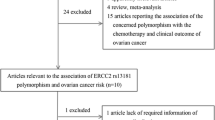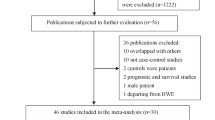Abstract
Several reports on the association between the BRCC5 gene polymorphism and ovarian cancer risk have been published recently, but the estimates of the risk vary widely. We thus performed a meta-analysis in an effort to determine the association. To identify the eligible studies, we searched the PubMed, Embase, and CNKI databases, and reviewed all original studies retrieved as well as their citations. The risk of ovarian cancer was estimated using odds ratio (OR) and its 95 % confidence interval (CI). Meta-analysis of seven comparisons revealed an obvious rise in the risk of ovarian cancer under the CC vs. GG contrast model (OR = 1.52, 95 % CI = 1.07–2.16, P OR = 0.020). A similar increase was also indicated in the CC vs. GC + GG model (OR = 2.10, 95 % CI = 1.51–2.93, P OR < 0.001). Our meta-analysis indicates that the BRCC5 polymorphism may be a candidate modifier of ovarian cancer risk in Caucasians.




Similar content being viewed by others
References
Jackson SP. Sensing and repairing DNA double-strand breaks. Carcinogenesis. 2002;23(5):687–96.
Helleday T. Pathways for mitotic homologous recombination in mammalian cells. Mutat Res. 2003;532(1–2):103–15.
Yamamoto A et al. Cell cycle-dependent expression of the mouse Rad51 gene in proliferating cells. Mol Gen Genet. 1996;251(1):1–12.
Yuan SS, Chang HL, Lee EY. Ionizing radiation-induced Rad51 nuclear focus formation is cell cycle-regulated and defective in both ATM(−/−) and c-Abl(−/−) cells. Mutat Res. 2003;525(1–2):85–92.
Vispe S, Defais M. Mammalian Rad51 protein: a RecA homologue with pleiotropic functions. Biochimie. 1997;79(9–10):587–92.
Baumann P, West SC. Role of the human RAD51 protein in homologous recombination and double-stranded-break repair. Trends Biochem Sci. 1998;23(7):247–51.
Tsuzuki T et al. Targeted disruption of the Rad51 gene leads to lethality in embryonic mice. Proc Natl Acad Sci U S A. 1996;93(13):6236–40.
Lim DS, Hasty P. A mutation in mouse rad51 results in an early embryonic lethal that is suppressed by a mutation in p53. Mol Cell Biol. 1996;16(12):7133–43.
Lambert S, Lopez BS. Inactivation of the RAD51 recombination pathway stimulates UV-induced mutagenesis in mammalian cells. Oncogene. 2002;21(25):4065–9.
Thacker J. The RAD51 gene family, genetic instability and cancer. Cancer Lett. 2005;219(2):125–35.
Hasselbach L et al. Characterisation of the promoter region of the human DNA-repair gene Rad51. Eur J Gynaecol Oncol. 2005;26(6):589–98.
Webb PM et al. Double-strand break repair gene polymorphisms and risk of breast or ovarian cancer. Cancer Epidemiol Biomarkers Prev. 2005;14(2):319–23.
Auranen A et al. Polymorphisms in DNA repair genes and epithelial ovarian cancer risk. Int J Cancer. 2005;117(4):611–8.
Jakubowska A et al. The RAD51 135 G > C polymorphism modifies breast cancer and ovarian cancer risk in Polish BRCA1 mutation carriers. Cancer Epidemiol Biomarkers Prev. 2007;16(2):270–5.
Smolarz B et al. Association between polymorphisms of the DNA repair gene RAD51 and ovarian cancer. Pol J Pathol. 2013;64(4):290–5.
Mantel N, Haenszel W. Statistical aspects of the analysis of data from retrospective studies of disease. J Natl Cancer Inst. 1959;22(4):719–48.
DerSimonian R, Laird N. Meta-analysis in clinical trials. Control Clin Trials. 1986;7(3):177–88.
Begg CB, Mazumdar M. Operating characteristics of a rank correlation test for publication bias. Biometrics. 1994;50(4):1088–101.
Egger M et al. Bias in meta-analysis detected by a simple, graphical test. BMJ. 1997;315(7109):629–34.
Hernandez JL, Weir BS. A disequilibrium coefficient approach to Hardy-Weinberg testing. Biometrics. 1989;45(1):53–70.
Levy-Lahad E et al. A single nucleotide polymorphism in the RAD51 gene modifies cancer risk in BRCA2 but not BRCA1 carriers. Proc Natl Acad Sci U S A. 2001;98(6):3232–6.
Vuorela M et al. Further evidence for the contribution of the RAD51C gene in hereditary breast and ovarian cancer susceptibility. Breast Cancer Res Treat. 2011;130(3):1003–10.
Nagle CM et al. Ovarian cancer survival and polymorphisms in hormone and DNA repair pathway genes. Cancer Lett. 2007;251(1):96–104.
Wang WW et al. A single nucleotide polymorphism in the 5′ untranslated region of RAD51 and risk of cancer among BRCA1/2 mutation carriers. Cancer Epidemiol Biomarkers Prev. 2001;10(9):955–60.
Romanowicz-Makowska H et al. A single nucleotide polymorphism in the 5′ untranslated region of RAD51 and ovarian cancer risk in Polish women. Eur J Gynaecol Oncol. 2012;33(4):406–10.
Cheng D et al. RAD51 Gene 135G/C polymorphism and the risk of four types of common cancers: a meta-analysis. Diagn Pathol. 2014;9(1):18.
Parshad R et al. Deficient DNA repair capacity, a predisposing factor in breast cancer. Br J Cancer. 1996;74(1):1–5.
Wang WTM, Doody M, Tarone RE, Struewing JP. A single nucleotide polymorphism in the 5-prime-UTR of RAD51 is associated with the risk of breast cancer among BRCA1/2 mutation carriers [abstract]. Am J Hum Genet. 1999;65:A22.
Ford D et al. Genetic heterogeneity and penetrance analysis of the BRCA1 and BRCA2 genes in breast cancer families. The Breast Cancer Linkage Consortium. Am J Hum Genet. 1998;62(3):676–89.
Conflict of interest
None.
Author information
Authors and Affiliations
Corresponding author
Rights and permissions
About this article
Cite this article
Liang, H., Li, Y., Luo, RY. et al. An increased risk of ovarian cancer associated with polymorphism in BRCC5 gene in Caucasian populations. Tumor Biol. 35, 9179–9184 (2014). https://doi.org/10.1007/s13277-014-2135-2
Received:
Accepted:
Published:
Issue Date:
DOI: https://doi.org/10.1007/s13277-014-2135-2




